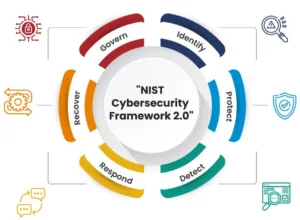
Table of Contents
This blog is about exploring the potential of Artificial Intelligence and Machine Learning in cyber security.
Introduction of Artificial Intelligence and Machine Learning
Artificial Intelligence (AI) is a field that focuses on creating intelligent systems capable of performing tasks that generally require human intelligence. It involves the development of algorithms and models that enable machines to perceive, reason, learn, and make decisions. AI encompasses a wide range of technologies and applications, including natural language processing, computer vision, and expert systems.
Machine Learning (ML) is a subset of AI which focuses on designing algorithms that allow computers to learn from data and improve their performance over time without being explicitly programmed. ML algorithms enable machines to identify patterns, make predictions, and make data-driven decisions. By analyzing large volumes of data, ML algorithms can uncover hidden insights and provide valuable solutions in various domains, including cyber security.
Advantages of using Artificial Intelligence and Machine Learning in cybersecurity
AI and ML are used in various ways in the field of cybersecurity to enhance detection, prevention, and response capabilities.
Here are some key applications of AI and ML in cybersecurity:
1. Advanced Threat Detection: AI and ML algorithms can analyze large volumes of data, such as network traffic logs, system logs, and user behavior, to identify patterns and anomalies indicative of potential cyber threats. By establishing baseline behavior and detecting deviations, these algorithms can identify malicious activities, such as malware infections, intrusions, or insider threats.
2. Malware Detection: AI and ML techniques can be employed to identify and classify different types of malware. ML algorithms can learn from known malware samples to develop models that can recognize new and previously unseen malware variants, improving the effectiveness of malware detection and reducing false positives.
3. Anomaly Detection: AI and ML models can identify anomalous behavior by comparing observed activities to expected patterns. These models can detect unusual network traffic, unauthorized access attempts, or suspicious user behavior that may indicate a potential security breach.
4. User and Entity Behavior Analytics (UEBA): AI and ML algorithms can analyze user behavior, such as login patterns, application usage, and data access, to establish normal behavior profiles. Any deviations from these profiles can be flagged as potentially malicious activities, helping to detect insider threats, compromised accounts, or unauthorized access attempts.
5. Security Information and Event Management (SIEM): AI and ML can enhance SIEM systems by automating log analysis, correlation, and alert prioritization. ML algorithms can learn from historical data and patterns of security incidents to improve the accuracy of threat detection and reduce false positives.
6. Predictive Analytics: AI and ML can be utilized to analyze historical data and generate predictive models for future cyber threats. By identifying trends, patterns, and indicators of compromise, these models can provide organizations with proactive insights and recommendations to strengthen their defenses before potential attacks occur.
7. Vulnerability Management: AI and ML techniques can assist in identifying and prioritizing vulnerabilities in systems and applications. ML algorithms can analyze vulnerability data, exploit frameworks, and patch history to prioritize the most critical vulnerabilities for remediation, enabling security teams to allocate resources effectively.
8. Automated Incident Response: AI and ML algorithms can automate incident response processes by analyzing security alerts, correlating events, and suggesting appropriate actions. This accelerates incident response times, allowing security teams to mitigate and contain security incidents more efficiently.
9. Fraud Detection: AI and ML algorithms excel in detecting fraudulent activities in financial transactions, such as credit card fraud or identity theft. They can identify patterns and anomalies, enabling the timely detection and prevention of fraudulent incidents.
10. Adaptive Defense: AI and ML models can learn from evolving cyber threats and adapt their defense mechanisms accordingly. As attackers continuously develop new techniques, AI and ML algorithms can keep pace by learning from past attacks and adjusting security measures to counter emerging threats effectively.
Examples of successful usage of Artificial Intelligence and Machine Learning in Cybersecurity
Several successful AI and ML driven threat detection systems have made a significant impact on cybersecurity. Here are a few examples:
1. IBM Watson for Cyber Security: IBM Watson, a cognitive computing system, has been applied to cyber security to analyze vast amounts of structured and unstructured data. By leveraging AI and ML, Watson can identify and prioritize potential threats with high accuracy. It can understand natural language queries, sift through security research, and provide actionable insights to security analysts, augmenting their capabilities and speeding up the incident response process.
2. Darktrace: Darktrace utilizes AI algorithms to detect and respond to cyber threats in real time. Its AI-powered system learns the unique “pattern of life” for each user and device on a network, enabling it to detect anomalies and identify potential threats. Darktrace’s autonomous response capability can take immediate action to neutralize threats, minimizing the impact of cyber attacks.
3. CylancePROTECT: CylancePROTECT is an AI-driven endpoint protection solution that uses ML algorithms to identify and prevent malware and other threats. Its algorithms analyze file behavior, characteristics, and other attributes to determine if a file is malicious. This approach allows CylancePROTECT to detect and block new and unknown threats, even without relying on traditional signature-based detection methods.
4. FireEye’s AI-Enabled Malware Detection: FireEye has developed AI-based solutions that use ML algorithms to analyze malware behavior and identify previously unseen threats. By analyzing features and patterns, these systems can identify advanced malware strains that may evade traditional signature-based detection methods. FireEye’s AI-driven malware detection capabilities have proven effective in identifying and mitigating sophisticated cyber attacks.
5. Amazon GuardDuty: Amazon GuardDuty is a cloud-based threat detection service that uses AI and ML to analyze network traffic, DNS data, and other indicators to detect potential threats. It leverages anomaly detection algorithms to identify suspicious activities and generate security alerts. GuardDuty’s AI-driven approach helps customers protect their AWS environments from a wide range of threats, including unauthorized access attempts and compromised instances.
These examples demonstrate the effectiveness of AI-driven threat detection systems in improving cyber security. By leveraging AI and ML algorithms, these systems can detect and respond to threats in real time, enhance detection accuracy, and provide valuable insights to security teams. As cyber threats continue to evolve, AI-driven solutions play a crucial role in strengthening defenses and mitigating the risks associated with advanced cyber attacks.
Enhancing Incident Response with AI and ML
AI and ML can significantly improve incident response processes by enhancing speed, accuracy, and efficiency. Here’s how AI and ML technologies can contribute to better incident response:
1. Automated Alert Triage: AI and ML algorithms can automatically analyze and triage security alerts, prioritizing them based on their severity and potential impact. By considering historical data, threat intelligence feeds, and contextual information, these algorithms can reduce the manual effort required to evaluate and prioritize alerts, allowing security teams to focus on high-priority incidents.
2. Threat Hunting and Investigation: AI and ML can assist in threat hunting activities by analyzing vast amounts of security data, including logs, network traffic, and system events. ML algorithms can identify patterns, anomalies, and indicators of compromise that may be difficult for human analysts to detect. This helps uncover hidden threats and accelerates the investigation process by providing valuable insights and leads.
3. Behavior Analytics: AI and ML models can learn normal behavior patterns for users, systems, and applications. By establishing baselines, these models can detect deviations that may indicate suspicious or malicious activities. This allows for early detection of insider threats, compromised accounts, and unauthorized access attempts, enabling proactive response measures.
4. Incident Analysis and Classification: ML algorithms can analyze incident data, including incident reports, logs, and system metadata, to identify commonalities and categorize incidents based on their characteristics. This automated incident classification helps in identifying patterns, understanding attack techniques, and making data-driven decisions for response and mitigation.
5. Threat Intelligence and Contextual Insights: AI-powered systems can ingest and analyze large volumes of threat intelligence feeds, vulnerability databases, and other external sources to provide context and insights during incident response. This includes information on known indicators of compromise, historical attack patterns, and emerging threats. Such contextual information helps analysts make informed decisions and respond effectively to incidents.
6. Automated Remediation and Containment: ML algorithms can suggest automated remediation actions based on predefined playbooks and response procedures. These algorithms can evaluate the severity of an incident, assess the potential impact, and recommend appropriate containment actions. Automated containment measures can help minimize the spread of an incident and reduce the time required for manual response.
7. Post-Incident Analysis and Learning: AI and ML algorithms can learn from past incidents and identify trends and patterns in attack techniques. This knowledge can be used to improve future incident response processes, update security policies, and enhance proactive defense measures. By leveraging AI and ML technologies, incident response processes can become more proactive, efficient, and effective. These technologies enable faster and more accurate identification of incidents, better decision-making based on contextual insights, and automation of response actions, ultimately reducing the overall impact of cyber attacks and enhancing an organization’s security posture.
Challenges and Limitations of AI and ML in Cyber Security
While AI and ML have brought significant advancements to the field of cyber security, there are also challenges and limitations that need to be considered. Here are some key challenges and limitations of AI and ML in cyber security:
1. Adversarial Attacks: AI and ML models can be vulnerable to adversarial attacks, where malicious actors intentionally manipulate inputs to deceive or bypass the models’ defenses. Adversarial attacks can lead to false positives or false negatives, undermining the reliability and effectiveness of AI-driven security systems.
2. Limited Training Data: AI and ML models heavily rely on training data to learn patterns and make accurate predictions. In cyber security, obtaining high-quality, diverse, and representative training data can be challenging. The lack of comprehensive and up-to-date data may result in models that are not robust enough to handle novel or sophisticated cyber threats.
3. Bias and Discrimination: AI and ML models can inherit biases present in the data used for training, potentially leading to discriminatory outcomes. In cyber security, biases can impact decisions related to threat identification, user profiling, and incident response. Addressing bias and ensuring fairness in AI-driven cyber security systems is crucial to maintain ethical and unbiased practices.
4. Interpretability and Explainability: AI and ML models often operate as black boxes, making it challenging to understand the underlying decision-making process. The lack of interpretability and explainability hinders the ability to trust and validate the outcomes of AI-driven security systems. This can be a significant limitation in critical situations where transparency and accountability are essential.
5. Model Robustness and Generalization: AI and ML models may struggle to generalize well to new or unseen scenarios. Models trained on historical data may not adequately adapt to evolving cyber threats and attack techniques. Robustness against previously unseen attacks and the ability to generalize across different environments and contexts remain ongoing challenges.
6. Cost and Resource Requirements: Implementing AI and ML solutions in cyber security often requires substantial computational resources, specialized expertise, and infrastructure. Organizations may face challenges in terms of cost, scalability, and operational requirements when adopting AI-driven security systems.
7. Human Expertise and False Positives: AI and ML models can generate false positives, alerting security teams to potential threats that turn out to be benign. The high volume of alerts generated by AI-driven systems can overwhelm security analysts, requiring significant human expertise to analyze and validate the alerts effectively.
8. Regulatory and Legal Considerations: The use of AI and ML in cyber security raises concerns regarding privacy, data protection, and compliance with regulations. Organizations must ensure that AI-driven security solutions adhere to legal and regulatory requirements, including data privacy laws, ethical guidelines, and industry standards.
It is crucial to acknowledge these challenges and limitations to effectively harness the power of AI and ML in cyber security. Continuous research, advancements in algorithmic techniques, and a multidisciplinary approach that combines human expertise with AI-driven technologies are necessary to overcome these challenges and mitigate the associated risks.
Conclusion
The transformative potential of AI and ML in cyber security lies in their ability to revolutionize threat detection, response times, and proactive defense strategies. Their ability to analyze vast amounts of data and continuously learn from it empowers organizations to stay ahead of evolving cyber threats and protect their critical assets more effectively.By harnessing the power of these technologies, organizations can stay one step ahead of adversaries, strengthen their security posture, and safeguard critical assets and data in an increasingly digital and interconnected world.
Read more on “https://cybertechworld.co.in” for such insightful cybersecurity related content.




















Your article helped me a lot, is there any more related content? Thanks!
Your article helped me a lot, is there any more related content? Thanks!